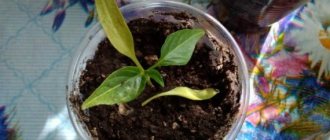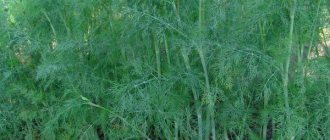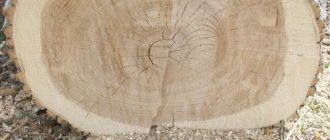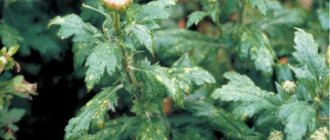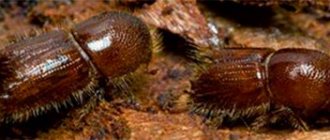In summer, many ornamental plants suffer from fungal diseases. They are covered with a whitish coating, which is clearly visible on the leaves. If powdery mildew on roses is not treated, it spreads to the stems and buds of flowers. To begin treatment, it is necessary to understand the cause of the disease and select a method for eliminating the disease. In a short time, the rose garden loses its decorative effect and in just a week, healthy bushes are affected.
What does a rose affected by powdery mildew look like?
A gardener is unlikely to confuse this disease of roses with another pathology. Externally, the bush looks as if it was sprinkled with something white or milk was spilled on it. This is the mycelium of powdery mildew. As the spores mature, the plant becomes covered with droplets of liquid, similar to dew. In common parlance, powdery mildew is also called white or flour. Its causative agent: the fungus Sphaerotheca pannosa. Bushes are most often affected by it in the first half of summer.
The spores of the pathogen are found in plant debris and immediately after winter they begin to be released, affecting healthy specimens. The lower leaves are affected first, then the fungus spreads to the upper parts of the plant. The optimal environment for the development of the pathogen is considered to be warm, humid weather with a sharp change in temperature. It usually happens in June. The fungus spreads quickly in rose bushes and is additionally carried by insects and wind.
The most common diseases of roses
Roses can get sick too. The plant cannot complain of being unwell, so pay more attention to its appearance. After all, any disease will manifest itself sooner or later. Dividing all the diseases of this culture into groups, we get:
- fungal diseases;
- root rot;
- diseases caused by bacteria;
- viral diseases;
- non-infectious lesions.
Diseases caused by fungi include the common powdery mildew, rust, several types of bark necrosis, gray rot, drying out of branches, various types of spots and others. In fact, white sclerotial rot, which is one of the root rots, is also a fungal disease that occurs in the roots of roses that are invisible to the eye.
Pathogenic bacteria can easily destroy a plant. An example of such a disease is bacterial cancer. Viruses cause jaundice, leaf streaking and viral wilt. These diseases are difficult to stop, but they can be prevented if you do not forget about prevention.
Under the influence of external factors, non-infectious diseases often occur in plants. For example, sunburn, root soaking, natural aging. There is a considerable list of diseases associated with a deficiency of a certain microelement that is necessary for plant life: potassium, phosphorus, manganese, iron, nitrogen, calcium, magnesium.
Some diseases lead to the death of the plant, others are easily curable, and others can be avoided altogether if preventive measures are taken. Let's look at three common ailments of fungal origin. They not only can, but also need to be treated.
Symptoms of an affected bush
Externally, flour is not similar to other fungal diseases that affect roses. A white coating appears on the leaves. It may appear as a white powder and often affects young shoots. Ulcers and red-brown spots form on the leaf blades of the plant. And also on the stem of the plant, the fungus appears in the form of small growths. If powdery mildew is not treated, the growths become larger and spread quickly.
The bush stops growing, and its leaves become deformed and even fall off. First, the leaves that are located closer to the soil are affected, then the fungus spreads to the stem and buds of roses. Even after treatment with special preparations, the leaves no longer acquire their natural shape. They remain deformed.
The plant's photosynthesis process is disrupted due to the white powder on the leaf blades, and the bush stops receiving nutrients. He begins to waste away. Outwardly, downy mildew is similar to the disease, but the two diseases are different. With downy mildew, purple or brown spots form on young rose leaves. Mature leaves simply turn gray or light.
A coating similar to a cobweb appears on the back of the leaves. Gardeners often confuse these signs with acid rain or sunburn. Downy mildew is treated with an aqueous solution of boric acid.
Causes of defeat
Rose bushes suffer the most from torment. A fungal infection can be a result of high humidity or caused by improper watering. It is provoked by overwatering or, conversely, drought. The spread of the fungus is often associated with fog and rain or high concentrations of nitrogen in the soil.
It is possible to infect bushes in a shady area where there is little sun, and they are located nearby. Powdery mildew can be the result of one or more factors, but gardeners cite dampness and moisture as the main causes. To prevent flour from infecting roses, most often it is enough to adjust the care of the plant.
Popular: Methods for treating indoor roses from pests
Danger
Flower growers consider this fungus to be quite aggressive and quickly spreading. It can quickly cover the entire plant. If at first individual infrequent spots can simply be wiped off with your fingers, then later the infection spreads to larger areas and affects plant tissue.
Over time, the spots turn from white to brown. Black dots appear on the surface of the spot. So, the mushroom body matures, and the leaves begin to dry out, break, curl, die and fall off. Buds affected by a fungal infection stop blooming and delight the owner with beautiful flowers. A diseased bush may also bloom with large flowers with an unpleasant aroma.
Signs and causes of fungal infection of roses
Symptoms of powdery mildew on roses are a white powdery coating that resembles mold and shapeless spots on the leaves. Without treatment, healthy tissues become covered with marks and gradually darken. The top layer looks like thin felt. Weakened plants lose their decorative appearance, drop their buds or dry out.
Frequent causes of the disease remain heat (from +25 C), high humidity (70-80%) and stagnant indoor air for a long time. Lack of sunlight during prolonged rains activates the disease. If gardeners rarely ventilate the room and violate the rules of irrigation (flood, overdry) the plant, then favorable conditions arise for the development of fungus. The disease is provoked by poor soil aeration and residual water in the pan.
The disease comes from contaminated soil or from a new flower. If the owner has touched sick specimens, he will transfer the infection to healthy species with his hands. Microorganisms easily get from gloves, gardening tools into buds, tops or young shoots. By removing dried branches, you can introduce infection. Favorable conditions for development are created by:
- parasites;
- excess nitrogen fertilizers;
- calcium deficiency.
- thickened plantings.
Folk recipes
Traditional recipes are effective in the fight against flour. Such methods of killing fungus involve the use of natural and environmentally friendly products, compared to caustic chemicals.
To prepare a soda solution, you need to take seven grams of liquid soap and 30 g of soda ash. The ingredients are diluted until completely dissolved in five liters of water. Instead of liquid soap, you can use regular laundry soap. Roses from flour are treated with this solution two to three times a week.
Seven grams of copper sulfate are diluted in 0.3 liters of hot water until completely dissolved. In another container, dilute 5 grams of laundry soap shavings in five liters of water. The vitriol solution is gradually poured into the soap solution. The mixture is stirred while mixing. The treatment procedure is repeated three times a week.
A solution of potassium permanganate (2.5 grams of product per bucket of water) helps well against powdery mildew. Spraying is done once every five days. A recipe made from horsetail also saves you from torment. To do this, 100 grams of plant materials need to be brewed in a liter jar of boiling water. After this, the water is infused for 24 hours. After this, the mixture is brought to the required volume with six liters of water. Processing is carried out every three days.
A solution with ash will cope with a fungal infection. To do this, a kilogram of ash should be dissolved in a bucket of water. The solution should be infused for seven days. From time to time the water and ash are mixed. Rose bushes need to be treated regularly and daily. To make the product more viscous, you can add five grams of grated laundry soap to it.
The fungus is afraid of the mustard solution. To prepare it, you need to add four teaspoons of mustard powder to a bucket of warm water and stir well. After the mixture has cooled, you can begin processing the plants. It is carried out daily or every other day. Another caustic but effective remedy is an infusion with garlic. The head of garlic needs to be peeled and grated on a fine grater. After this, the pulp should be dissolved in a liter jar of water and allowed to brew for 24 hours.
Treatment with a product containing cow dung helps combat powdery mildew. To do this, it needs to be poured in a ratio of one to three. The mixture is infused for three days. After ripening the product, you need to bring it with water to double the volume. A solution of water and whey in a ratio of one to five is also effective. Processing is carried out every three to four days.
Popular: Causes of mealybugs: getting rid of orchids
How to process flowers, basic rules
To rid roses of powdery mildew and not harm the plant, you must follow some recommendations.
Basic rules for processing:
- Before spraying, you need to remove the affected leaves and shoots. This is due to the fact that they will no longer be able to restore functionality. Therefore, they need to be cut and burned.
- You cannot treat bushes directly after watering or rain. In this case, the absorbency of the leaves is reduced, so spraying will not bring a positive result. The best option is the evening in dry, windless weather.
- When using folk remedies and contact chemicals, it is necessary to treat the leaves and shoots of roses evenly on both sides. Otherwise, it will not be possible to completely remove the fungus from the plant.
- If an indoor rose is damaged, you need not only to spray the bush, but also to replace the top layer of soil in the pot, where entire colonies of fungal mycelium are usually concentrated.
- Powdery mildew must be combated comprehensively and regularly. To do this, 3-4 treatments with different preparations should be carried out at intervals of 7-14 days, depending on the stage of damage to the bush.
- Only freshly prepared solution should be used to treat bushes for 1 day. If stored for a longer period of time, it loses its effectiveness.
The working solution must be prepared immediately before use.
Pesticide
If the fungus has spread over a large area and continues to progress. Experienced gardeners recommend using special chemicals in this case. They are sold at any hardware store. These may be chemicals of the brand “Topaz”, “Acrobat-MC”, etc. Instructions for the use of such products can be found on the packaging. You should not treat with such drugs more often than in the instructions or make the concentration higher.
If folk remedies are unable to eliminate the fungal infection and the rose garden dies, then it is recommended to use fungicides. They stop the spread of infection and completely destroy fungal spores. In addition, these drugs will help roses regenerate. The remedies are both chemical and biological. Organic brands are safer for flowers and the environment.
But they are not very effective for treating powdery mildew. Experienced gardeners recommend using them to prevent fungal infections. Chemical drugs are more powerful and should not be overused. But such remedies will quickly cope with a fungal infection.
Fitosporin
Release form: powder. Preparation instructions: the powder is mixed with water in a ratio of one to two. After this, the mixture is infused for three hours. The same proportions are used for preparation, but the pasta is prepared in advance. This paste lasts longer. To prevent the aqueous solution from rolling off the leaves, it is recommended to add half a tablespoon of liquid soap to it. Phytosporin is commonly used to prevent and kill fungal infections. The frequency of use depends on the weather outside the window. If there is a lot of precipitation, then treatment is carried out once every seven days.
Alirin B
This is a remedy for the prevention and treatment of fungus. To prepare the solution, use two Alirin B tablets, add a little liquid soap (for stickiness) and ten liters of water. All components are mixed until completely dissolved. To make roses grow quickly, you can enrich the product with Zircon or Epin to stimulate it. If the product is used to prevent flour, then the concentration of the solution should be halved. Average price of Alirin B: 80–90 rubles per pack of tablets.
Fundazol
Release form: powder. To prepare a solution for treating rose bushes, dilute ten grams of powder in a bucket of water. Treatment with Fundazol is carried out three times per season.
Tilt CE
This is a more expensive fungicide. For processing, use 400 milligrams of emulsion per liter of liquid. Tilt CE retains its properties up to 14 days after treatment. But the procedure should be carried out if the outside temperature is below 30 degrees Celsius. Fungicides can be addictive when used regularly.
Treatment with fungicides
There are two types of drugs:
- chemical;
- biological.
The former pose a threat to the human body and the environment. But they are more effective, especially if they are fungicides that have a systemic effect. Capable of penetrating plant tissues and killing pathogens.
The biological species does not pose a particular danger to nature. Rather, on the contrary, there are even known types of substances that can somewhat improve soil fertility. They are often used as growth promoters. However, this group is less effective in combating powdery mildew than chemical agents.
Fitosporin-m
The biological agent is effective at the very beginning of infection or to prevent the disease. It is based on spores that can resist the development of the disease. Microorganisms are capable of creating substances that have properties similar to those of fungicides.
To disinfect the entire bush, the emulsion is sprayed. It is also recommended to irrigate the soil around the shoots. The effect of the medicine lasts no more than 10 days. After this period, the procedure must be repeated. Treatment is carried out in cloudy weather or in the evening, since Fitosporin-m does not tolerate exposure to ultraviolet rays.
Related article:
Why do the leaves curl and dry on an apple tree?
The medicinal composition is prepared by dissolving 2 g of powder in 1 liter of warm liquid. The drug in the form of a paste is diluted in a ratio of 200 g of substance per 2 liters of water. When processing shoots, add 1 tbsp to a bucket of liquid. concentrate. To activate microorganisms, the composition should be left for a couple of hours. In cold conditions, the properties of the solution do not decrease.
Alirin-B
Since the product is biological and non-toxic, it can also be used indoors. Effectively destroys fungal pathogens and restores soil microflora. At 10 l. 5 tablets of fungicide are dissolved in the liquid and mixed thoroughly.
The prepared mixture loses its medicinal properties after a day, so it is better to use it immediately after preparation. Spraying is carried out at least 3 times at an interval of a couple of weeks. Combination with biological insecticides is allowed.
Fundazol
A systemic fungicidal drug used to treat indoor flowers infected with fungus. The protective properties last 7 days, the maximum antifungal effect is observed in the first 72 hours after treatment
Related article:
The most effective ways to control pests
The product can not only disrupt the reproductive function of spores, but also poison leaf beetles, aphids, and spider mites. To completely cure infected bushes, it is necessary to carry out 3 procedures with an interval of 2 weeks. An increase in the number of treatments contributes to the development of resistance to the composition.
The solution is prepared at the rate of 5 g of powder per 1 liter of liquid. The resulting mixture is sprayed onto the plants and the soil around them. Since spores can spread to neighboring crops, they are also sprayed for preventive purposes.
Tilt CE
A systemic antifungal substance, part of which is propiconazole. Destroys oidium on various plants. Increased temperature enhances the healing properties. The components of the drug quickly penetrate plant tissue and begin to destroy the pathogen within 6 hours. The therapeutic effect is observed within 3 weeks, and the protective effect is at least 25 days.
To prepare the solution, you need to dilute 0.5 ml of the substance in 1 liter of liquid. If the infection is in the initial stage, 1 spray is enough. In advanced cases, the procedure is performed twice with an interval of 2 weeks. The fungicide can be mixed with other non-alkaline insect repellent chemicals.
Related article:
How to protect tomatoes from late blight
The drug can not only destroy the fungus, but also accelerate the regeneration of damaged tissues. For indoor flowers, the drug is available in 1 ml ampoules. The effectiveness of the product decreases at high humidity and low temperature. Since the drug is moderately toxic for warm-blooded animals, it is better to carry out treatment on the street or in an open balcony, while observing safety precautions.
To prevent the fungus from getting used to the drugs, spraying with one fungicide should be carried out no more than 3 times in a row.
Subtleties of processing
Each gardener decides for himself which means to choose to destroy powdery mildew. These can be chemical or biological drugs or folk remedies. But before treating against fungus, gardeners should consider a number of rules that will make the procedure more effective. First, diseased leaves, stems and infected buds are cut from the bush. After spraying with the medicine, you need to water the soil under the bush with it or, in general, remove the top layer of soil so that no fungal spores remain in it.
Popular: Three ways to effectively control ragweed
Treatment with medicinal products must be thorough. The entire surface of the bush is moistened with the solution along with the leaves, stems and buds. It is best to carry out the procedure at dusk or when it is cloudy so that the roses do not get sunburn. In addition to the affected plant, it is recommended to treat the entire front garden or flower bed to prevent the spores from spreading further. For prevention, it is recommended to use only traditional recipes. They will prevent roses from becoming infected and act as feeding, strengthening the plant’s immunity.
Advice on agricultural technology
In addition to therapeutic spraying, it is important to adjust crop care in order to create unfavorable conditions for the fungus.
If roses suffer from powdery mildew, during treatment it is recommended:
- Remove all diseased leaves from the plant and burn them.
- Remove old leaves from the lower tier of the bush.
- Reduce the number of waterings to a minimum. Irrigation should be done only after the top layer of soil has dried.
- Do not moisten by sprinkling.
- Do not fertilize.
- Renew the top of the soil in the flower garden.
Related article:
Why do the leaves curl and dry on an apple tree?
After an illness, plants need abundant feeding containing potassium and phosphorus. Nitrogen fertilizers are not recommended.
Additional methods of combating flour
Conventional agrotechnical practices, when done correctly, can protect the rose garden from powdery mildew. The owner of the flowers must promptly weed the weeds and loosen the soil in the garden bed. When planting plants, the optimal scheme is selected. For miniature flowers, an interval of at least 50 centimeters is maintained.
For medium-sized bushes, maintain a distance between plants of 60 to 70 centimeters. For climbing and semi-climbing varieties, the interval increases from 100 to 120 centimeters between plants. If the bushes are planted closer, the soil begins to dry out. All parts of plants affected by the disease are torn off, taken outside the boundaries of the site and burned.
You should not add a lot of nitrogen fertilizers to the soil, so as not to provoke the development of leucorrhoea. To make the bushes more resistant to fungus, it is necessary to feed the plant in the first and last ten days of May with vermicompost (250 grams of the substance per bucket of water). One rose bush requires a half-liter jar of solution. When planting, the owner of the site must select those varieties that are resistant to fungal infections. It could be “Aphrodite”, “Gloria Day”, “Cadillac”, etc.
Preventive measures
It is difficult to get rid of leucorrhoea, so it is better to carry out timely prevention of the fungus. If a rose is planted in the shade, then the likelihood of being affected by powdery mildew is much higher than in a lighted place. Crowding of rose bushes also promotes the rapid spread of infection. Before planting the plant, it is recommended to treat the substrate with a fungal solution.
It is important not to flood the bushes so as not to cause activation and development of torment spores. In rainy summers, the area with roses must be drained. In autumn, it is recommended to eliminate all plant debris in the garden or garden. If powdery mildew has settled in the garden, then next June the plants must be treated early. The affected bushes are not thrown away or used for humus, but burned.
Currently reading:
- How to grow Chinese cabbage in open ground
- Persistent, large harvest of cucumbers after planting them as seedlings
- Planting to decorate the site with three types of coniferous trees
- Increased potato yield using Dutch technology
Share the news on social networks
About the author: Victoria Semyonovna Nakhodkina
Leading researcher at the laboratory of vegetable and berry crops, Yakut Scientific Research Institute of Agriculture, Siberian Branch of the Russian Academy of Agricultural Sciences, Republic of Sakha (Yakutia).
How to prevent
If you carry out all agrotechnical measures correctly and on time, you can prevent the appearance of powdery mildew on roses.
Provide the right conditions for planting
- Buy rose seedlings only in specialized stores or nurseries. Do not trust the market, so as not to be disappointed later.
- The purchased seedling must be healthy, well developed, and have at least three shoots.
- Ask about its age, which group it belongs to, whether it is grafted or rooted.
- In spring, roses can be planted until the end of May. In the fall, the deadline is October 20. And sometimes earlier, it all depends on the weather.
- If you cannot plant a seedling right away, then to preserve it, wrap the roots with a damp cloth, and the entire bush with a damp newspaper, put it in a plastic bag and tie it. Now it can be stored in a cool place for up to ten days.
- Dig a hole for planting a seedling in accordance with the size of the roots. It should not be deep and very wide. Dig it so that the roots can be well spread out.
- Place compost mixed with soil at the bottom of the hole. Place a seedling in it. Spread out the roots. Cover with soil so that the grafting site is buried 3-5 cm. If it is deeper, the grafting site falls into cold layers of soil. This makes the rose grow poorly. If it is planted higher, wildflowers will begin to grow actively. It will be difficult to get rid of them later.
- Then the rose must be watered generously. After this, hill up to 15 cm. When the buds begin to grow, unhill. If the rose was planted in the fall, then there is no need to unplant it.
- Try to plant roses in a place that is well lit by the sun. But not on the south side. Pests will attack her there. Climbing roses should be planted in a well-ventilated place. Ideally planted on the east or west side of the house.
Inspect your roses regularly
To prevent the rose from getting sick, it must be examined regularly. This is how you can notice the first signs of powdery mildew. Carefully inspect the stems, leaves on both sides, buds, and flower petals. If you notice diseased parts of the plant, remove them immediately. And then spray the plant itself with a fungicide.
Remove weeds and fallen leaves
The soil around rose bushes should always be free of weeds and fallen leaves. If they are not removed in time, they will become a source of rose diseases. Pathogens of fungal diseases, in particular powdery mildew, overwinter in fallen leaves. Remove cut, diseased leaves immediately. This will prevent further spread of the infection.
Disinfect the tool
During pruning, it is necessary to disinfect the tool. Otherwise, you yourself will transfer the disease from a diseased plant to a healthy one. For disinfection, you can use any alcohol-containing or chlorine-containing product available to you. Just don't heat the tool. This deteriorates its cutting part and changes the quality of the metal.
Don't overdo it with nitrogen fertilizers
You can easily understand that you have gone too far with nitrogen by the abundance of powerful rose stems and dark green leaves, a small number of buds, and late flowering. Such a plant becomes a delicacy for aphids. She colonizes him. All this taken together is a direct path to the occurrence of fungal diseases, including powdery mildew.
Provide adequate amounts of potassium and phosphorus
A nutrient deficiency can be a trigger for the appearance of powdery mildew on roses. In particular, potassium and phosphorus. It is these macroelements that are responsible for strengthening the plant’s immunity, its immunity to fungal diseases, the development of the root system, and resistance to low temperatures. Therefore, it is necessary to strictly adhere to the feeding schedule.
During the season you need to carry out three mandatory feedings:
- The first is in April, when the plant wakes up after winter. During this period, the rose requires more nitrogen, and phosphorus and potassium in equal proportions. For feeding, you can use any complex mineral fertilizer. Pay attention only to the proportional ratio of the components. A few days after mineral fertilizing, apply organic fertilizer (mullein infusion). This will improve the soil structure.
- The second - during tying the buds. The share of nitrogen fertilizers is decreasing, while the share of potassium and phosphorus fertilizers is greatly increasing. The principle of application is the same as in the first case.
- The third - after the first flowering. They refuse nitrogen fertilizers and feed only phosphorus and potassium fertilizers.
Spray roses with protective agents
To prevent the appearance of powdery mildew on roses, carry out preventive treatment of bushes with fungicidal solutions. For prevention, you can use biofungicides, such as phytosporin. Be sure to apply it in early spring, before the buds begin to grow, and also before sheltering for the winter. During the growing season, you can use folk remedies by spraying roses every two weeks with a soap-soda solution or whey.
In autumn, remove dry leaves and dig up the soil
If you do not remove the dry leaves under the rose bushes and do not dig up the soil underneath them, then the spores of fungal pathogens will survive the winter safely. You cover the roses, the leaves begin to rot, parasitic fungi feel good and cozy there. Why destroy roses because of your laziness? When removing leaves, do not compost them. They can infect him. Better burn the leaves.
Initially select varieties that are resistant to powdery mildew.
When choosing a rose to plant in your rose garden, pay attention to its resistance to powdery mildew. Don't blindly trust the seller. Look in the directory, chat on the forums. Only after this decide to purchase a new resident.
Experienced flower growers recommend the following varieties:
- Purple tige (Purple tiger);
- Sommersonne;
- Cadillac;
- Hot chocolate;
- Aphrodite.
Causes of the disease
Powdery mildew manifests itself most clearly on roses; measures to combat the disease depend on the reasons that provoked the fungal infection. Risk factors include:
- increased air humidity;
- over- or under-watering;
- a large amount of precipitation;
- high concentration of nitrogen in the soil;
- insufficient exposure to sunlight;
- the bushes are too close to each other.
Infection of roses occurs when a favorable environment for the growth of the fungus is created, and this is, first of all, dampness. Therefore, for effective treatment and prevention of re-infection, care should be adjusted and comfortable conditions for the life of the plant should be provided.
